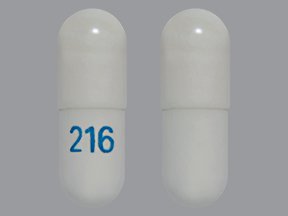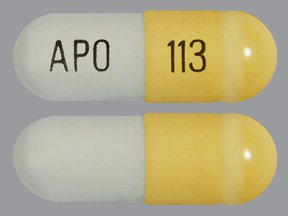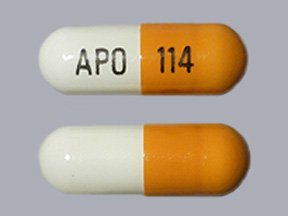Neurontin capsules, drug packaging, and formulation.
Capsules of white color, with the blue inscription “Neurontin 100 mg” and “PD”; the contents of the capsules are white or almost white powder.

1 capsule of Gabapentin 100 mg
Excipients: lactose, corn starch, talc.
10 pieces – cellular planimetric packings (2) – cardboard packs.
10 pieces – cellular planimetric packings (5) – cardboard packs.
10 pieces – cellular planimetric packings (10) – cardboard packs.
Capsules of light yellow color, with the gray inscription “Neurontin 300 mg” and “PD”; the contents of the capsules are white or almost white powder.
 1 capsule of Gabapentin 300 mg
1 capsule of Gabapentin 300 mg
Excipients: lactose, corn starch, talc.
10 pieces – cellular planimetric packings (2) – cardboard packs.
10 pieces – cellular planimetric packings (5) – cardboard packs.
10 pieces – cellular planimetric packings (10) – cardboard packs.
Capsules of gray-orange color, with the gray inscription “Neurontin 400 mg” and “PD”; the contents of the capsules are white or almost white powder.
 1 capsule of Gabapentin 400 mg
1 capsule of Gabapentin 400 mg
Excipients: lactose, corn starch, talc.
10 pieces – cellular planimetric packings (2) – cardboard packs.
10 pieces – cellular planimetric packings (5) – cardboard packs.
10 pieces – cellular planimetric packings (10) – cardboard packs.
The tablets are covered with a white shell, have an elliptical shape, with the inscription “NEURONTIN 600”, printed in black.
Pharmacological effect
When penetrating the body, gabapentin begins to bind to the α2-σ-subunit, which is potential-dependent on the calcium channels. This action leads to the fact that the flow of calcium ions is significantly reduced, which means that the risk of neuropathic pain is reduced.
In the body, gabapentin enhances the synthesis of GABA, as well as inhibits the release of neurotransmitters belonging to the monoamine group. Bioavailability decreases with increasing the dose. Its maximum concentration in the body is reached only after 120-180 minutes after taking the capsule.
Indications for use of Neurontin capsules
The main pathological conditions in which gabapentin is administered include:
- Localized (focal, partial) idiopathic epilepsy and epileptic syndromes with convulsive seizures with a focal start.
- Localized (focal, partial) symptomatic epilepsy and epileptic syndromes with simple partial seizures.
- Localized (focal, partial) symptomatic epilepsy and epileptic syndromes with complex partial convulsive seizures.
- Neuralgic manifestations after shingles.
Contraindications
Contraindications for the use of the antiepileptic drug Gabapentin and its analogs include hypersensitivity to the components that make up the drug, as well as age to 12 years. The administration of this drug to patients with renal insufficiency requires should be made with caution.
Special instructions and precautions
- Patients with impaired renal function, as well as patients on hemodialysis, need a correction of the dosing regimen of Neurontin.
- Elderly patients may need to adjust the dosage regimen of Neurontin due to the fact that this category of patients may have a reduction of renal clearance.
- When symptoms of pancreatitis appear, Neurontin should be discontinued. In the case of appearance of side effects in adults: drowsiness, ataxia, dizziness, fatigue, nausea and/or vomiting, weight gain and in children: drowsiness, hyperkinesia, and hostility, it is necessary to consult a doctor.
- Neurontin is not an effective drug for treating abscessed seizures.
- Although the withdrawal syndrome with the development of seizures has not been noticed during the treatment with Neurontin, nevertheless a sharp cessation of therapy with anticonvulsants in patients with partial seizures can provoke a convulsive status. If necessary, reduction of a dose, cancellation of Neurontin or its replacement with an alternative drug should be gradually made for at least 1 week.
With the combined use of Neurontin with other anticonvulsants, false-positive results of the Ames N-Multistix SG dipstick protein determination test were recorded. To determine the protein in the urine it is recommended to use a more specific method of precipitation of sulfosalicylic acid. - During the period of Neurontin treatment, avoid drinking alcohol.
- Efficacy and safety of neuropathic pain therapy with Neurontin in patients under 18 years old are not established.
- Efficacy and safety of monotherapy with Neurontin in the treatment of partial seizures in children under 12 years old and additional therapy with Neurontin in the treatment of partial seizures in children under 3 years old are not established.